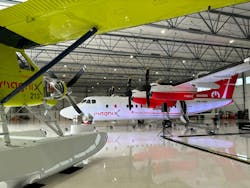magniX announces next phase in NASA's EFPD program
EVERETT, Wash. - magniX in Everett, Wash. has unveiled a De Havilland DHC-7 aircraft in Seattle as part of the next phase in the National Aeronautics and Space Administration's (NASA) Electrified Powertrain Flight Demonstration (EPFD) program. The aircraft will be retrofitted with magniX's electric powertrains, marking a significant step in the program aimed at advancing electric aviation.
The aircraft, displayed with logos from magniX, NASA, and Air Tindi—the provider of the Dash 7—marks progress in a series of milestones achieved throughout 2024. In February, magniX completed the Preliminary Design Review (PDR) for the retrofit, while in April, the company successfully tested its magni650 electric engine at NASA’s Electric Aircraft Testbed (NEAT) facility in Ohio, demonstrating the engine's performance at altitudes up to 27,500 feet. Baseline flight tests for the Dash 7 were completed in June, providing critical data ahead of the aircraft's modification.
In the next phase of the EPFD program, one of the aircraft's four turbine engines will be replaced with a magniX electric powertrain, with test flights scheduled for 2026. A second turbine engine will also be substituted in subsequent stages, with the overall configuration expected to reduce fuel consumption by up to 40%.
“MagniX and NASA are demonstrating that sustainable flight can be realized with technology that we have available today,” said Ben Loxton, Vice President of EPFD and Electric Storage Systems at magniX. “The EPFD program is accelerating its readiness for entry into service, prioritizing safety and the highest standards of performance.”
MagniX CEO Reed Macdonald echoed these sentiments, stating, "Integrating our game-changing electric powertrains into a regional airliner such as the Dash 7 represents a major step forward in bringing electric solutions into the business of aviation."
NASA's Robert A. Pearce, associate administrator for the Aeronautics Research Mission Directorate, highlighted the program's broader impact: “Hybrid electric propulsion on a megawatt scale accelerates U.S. progress toward its goal of net-zero greenhouse gas emissions by 2050, benefitting all who rely on air transportation every day.”
